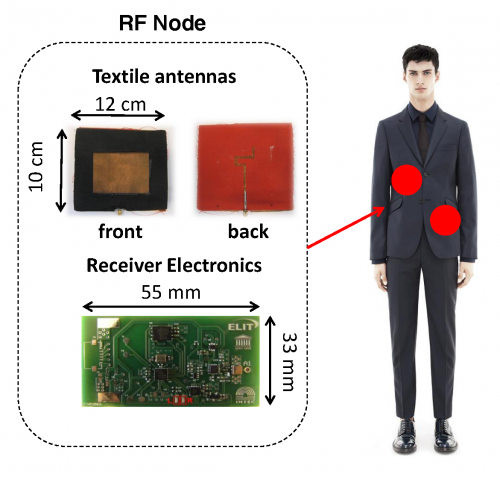Personal, Distributed Exposimeter (PDE)
Radio Frequency (RF) electromagnetic (EM) radiation is increasingly used in modern day society. The emissions of RF radiation are regulated and limited in order to prevent possible health effects. Besides the previously studied thermal effect of RF radiation, epidemiological studies are now being executed to determine possible long-term health effects. Both compliance and epidemiological studies require measurement techniques for assessment of exposure to RF radiation.
The devices used to measure exposure to RF radiation are Personal Exposimeters (PEMs). These are body-worn devices, which are meant to measure the instantaneous incident electric-field strength of RF radiation. PEMs have some clear advantages: First, they are worn on the body and will thus measure at the same location and time as the subject who is wearing the PEM. Second, they can measure simultaneously in different frequency bands. However, these devices are affected by severe measurement uncertainties, in which the uncertainty caused by the presence of the body is an important factor.
A possible approach to reduce the uncertainty caused by the presence of the body is the usage of a Personal, Distributed Exposimeter (PDE). This measurement device consists of different antennas which are distributed on the body and used to detect incident RF radiation. This variation of antenna location on the body allows one to reduce the influence of the body.

In this area of research, the waves group has acquired several competences:
- Characterization and calibration of on-body antennas for existing and future wireless technologies in anechoic, reverberation, and real environments.
- On-body calibration of PEMs and PDEs using both measurements and numerical simulations.
- Optimization of on-body locations of PEMs or nodes that make up a PDE.
- Determination of uncertainty budgets of devices used for personal exposure assessment.
- Evaluation of PEMs’ performance during compliance measurements near base station antennas.
- Executing and analyzing personal exposure measurements in several (micro-)environments.
- Statistical analysis and post-processing of RF EMF personal exposure measurements.
- ACCEDERA: ANSES funded, in collaboration with Unibas/Swiss TPH, Utrecht University, INERIS, and CREAL.
- University of Lille 1, France
- University of Rennes, France
- University of Basel (Unibas) / The Swiss Tropical Health Institute (TPH), Switzerland
- Utrecht University, The Netherlands
- INERIS, France
- Centre for Research in Environmental Epidemiology (CREAL), Spain
- Monash University, Australia
- Application of the PDE in the ACCEDERA project, where personal RF exposure is compared in five European Countries.
- A Thielens, et al., Personal Distributed Exposimeter for Radio Frequency Exposure Assessment in Real Environments"', Bioelectromagnetics, vol. 34, no. 7, pp. 563-567, 2013.
- A Thielens, P Vanveerdeghem, S Agneessens, P Van Torre, G Vermeeren, H Rogier, L Martens, W Joseph,Whole-Body Averaged Speci c Absorption Rate Estimation using a Personal, Distributed Exposimeter."', IEEE Antennas and Wireless Propagation Letters, vol. 14, pp. 1534-1537, 2015.
- A Thielens, P Vanveerdeghem, P Van Torre, S Gangler, M Roosli, H Rogier, L Martens, W Joseph, A Personal, Distributed Exposimeter: Procedure for Design, Calibration, Validation, and Application,"' Sensors, vol. 16, no. 180, 2016.